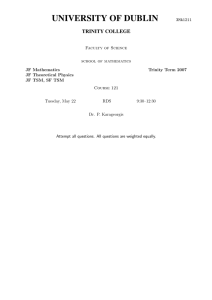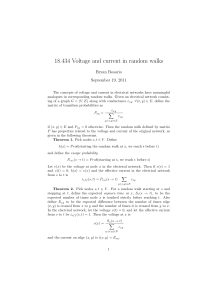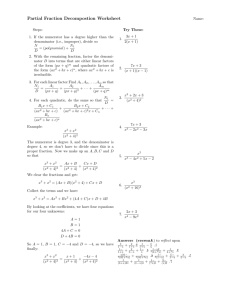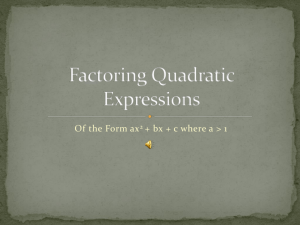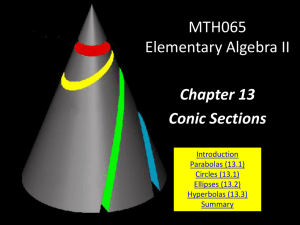Document 10943936
advertisement
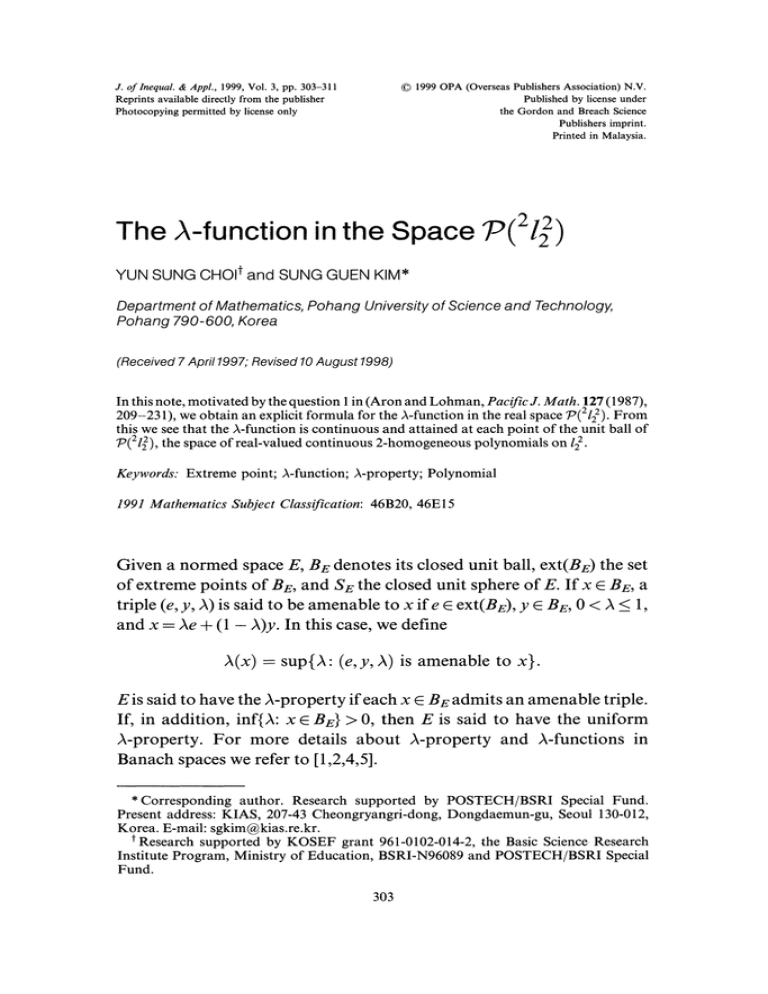
(C) 1999 OPA (Overseas Publishers Association) N.V.
Published by license under
the Gordon and Breach Science
Publishers imprint.
Printed in Malaysia.
J. oflnequal. & Appl., 1999, Vol. 3, pp. 303-311
Reprints available directly from the publisher
Photocopying permitted by license only
The A-function in the Space
79(21 )
YUN SUNG CHOIt and SUNG GUEN KIM*
Department of Mathematics, Pohang University of Science and Technology,
Pohang 790-600, Korea
(Received 7 April 1997; Revised 10 August 1998)
In this note, motivated by the question in (Aron and Lohman, Pacific J. Math. 127 (1987),
209-231), we obtain an explicit formula for the )‘-function in the real space T’(2122). From
this we see that the ),-function is continuous and attained at each point of the unit ball of
7:’(2122), the space of real-valued continuous 2-homogeneous polynomials on 122.
Keywords: Extreme point; )‘-function; )‘-property; Polynomial
1991 Mathematics Subject
Classification: 46B20, 46E15
Given a normed space E, Be denotes its closed unit ball, ext(Be) the set
of extreme points of Be, and Se the closed unit sphere of E. If x E Be, a
triple (e, y, A) is said to be amenable to x if e E ext(Be), y Be, 0 < A < 1,
and x- Ae + (1 A)y. In this case, we define
A(x) --sup{A" (e, y, A)
is amenable to
x}.
Eis said to have the A-property if each x Be admits an amenable triple.
If, in addition, inf{A: x Be} > 0, then E is said to have the uniform
A-property. For more details about A-property and A-functions in
Banach spaces we refer to [1,2,4,5].
*Corresponding author. Research supported by POSTECH/BSRI Special Fund.
Present address: KIAS, 207-43 Cheongryangri-dong, Dongdaemun-gu, Seoul 130-012,
Korea. E-mail: sgkim@kias.re.kr.
Research supported by KOSEF grant 961-0102-014-2, the Basic Science- Research
Institute Program, Ministry of Education, BSRI-N96089 and POSTECH/BSRI Special
Fund.
303
Y.S. CHOI AND S.G. KIM
304
Aron-Lohman [1] introduced the A-function, and calculated explicitly the A-function for the classical spaces Cx(T), ll (X), l(X) and c(X).
They showed that every finite dimensional normed space has the uniform
A-property.
Choi-Kim [3] obtained an explicit formula for the norm of the real
space "])(2/22 )" Let a, b, c E R, la[ <_ 1, Ibl _< and Icl <_ 2. Suppose P(x, y)
Then
ax2 + by 2 + cxy p(21) for the real Banach space
12
[[P(x, y)][
/f and only/f 4
c2
4(]a + b[- ab)
(,)
Using (,) we also classified the extreme points of the unit ball of 79(2122)"
For the real Banach space
12
ax2
P(x, y)
+ by2 + cxy ext(Bp())
if and only if
[al-lb[=l
or
O<[a[< 1, a--b, 4a2=4-c2
(**)
In this note, motivated by the question in [1], we obtain an explicit
formula for the A-function in the real space P(2/2 using (,) and (**).
From this we see that the A-function is continuous and attained at each
point of the unit ball of P(212). Finally, we give an explicit formula for the
norm and the A-function in 79(2/22).
LEMMA
Let P(x, y) ax2 + by2 + cxy in p(2/), [[PI[
-< 1. Then
A(ax2 + by2 + cxy)
A(sign(ab)min{[a[, [bl}x2 + max{[a[, [b[}y2 + [c[xy).
Proof It follows from the fact that the A-function is invariant with
respect to isometries.
-
THEOREM 2 Let P(x, y) ax2 + by2 + cxy in p(2/2),
A(ax2 + by2 + cxy)
IIPII
1. Then
+- ]a+b[- v/(a- b) +c
2
2
Therefore, the A-function & continuous and attained at each point ofBp( )
THE A-FUNCTION IN THE SPACE 79(2122
305
Proof By Lemma 1, may assume that la] _< ]bl-- b and c >_ 0.
Case
IIPI[ < 1. First, (,) shows that
4 c2 > 4(a + b) 4ab.
(A) Suppose that P(x, y) A(x2 + y2) + (1 A)Q(x, y) for
(1)
some
a
0 < A _< and E 79(2122), IlOll-< 1.
By Proposition 1.2(b) [1] we may assume Q
Q(x,y)--
1. Then
(-_)x2/ (be-.. )y2/ (1 A)xY"
C
and (,) shows that
<2
and
c
4-
a+b-2A
(2)
-A
1-A
If a + b 2A > 0, then Eq. (2) is equivalent to 4 2 4(a + b) 4ab,
contrary to (1). Suppose a + b- 2A < 0. Solving Eq. (2), we get
-4
_4
A=5+ 1( [a+b]+ V/ (a-b)2/c )
2
Since A < min{(1
+ a)/2, (1 + b)/2}-(1 + a)/2, we have
A=+Il([a+b[_v/(a
b)2 + c
2).
It is easy to check that
a+b
2
1( la/bl- V/(a-b) )
<-/
2
/C2
l+a
Hence
sup{A: (X2 / y2, Q, A) is amenable to P}
=+1l([a+b[_v/(a -b)2+c2).
Y.S. CHOI AND S.G. KIM
306
.
(B) Suppose that P(x, y) A(-x2 y2) -k- (1
0 < A < and O E 7(2122), [tOll
Then
A)Q(x, y) for some
_(+)x2+ (bl+. )yz+ (l_A)xyC
Q(x,y)=
and (.) shows that
_<1,
and
4-(1 cA)2: 41a b_2[ 4(...+ .)(bl +_ ).
(3)
Solving Eq. (3), we get
,
=---
la / bl + (a-b) = / c=
Note that
1-b
2
<-l([a+ bl+ v/(a
b) 2 -C
2)
Since A<min{(1-a)/2,(1-b)/2}-(1-b)/2, P does not admit an
amenable triple (-x2
(C) Suppose that P(x, y)= (lx ly +/- 2v/1 lxy) + (1 A)Q(x,
<_ <_ and
y) for some 0 < A <_ 1,
Then
Q x, y)
x:2 -k-
y2 _+_
A
and (.) shows that
b+l_l I-<1’
c+2Av/i _/2
<2
THE A-FUNCTION IN THE SPACE 7(2122)
307
and
c
a- )d
I_A
--4
1-/
(4)
Solving Eq. (4), we get
4(1 -a)(1 -b)-c2
4((b a)l + 2 a b 4- cx/1
12)
Computation shows that
4(1 a)(1 b) c:
-1<t<1 4((b
a)l / 2 a b 4- cx/1 12)
4(1 -a)(1 -b)-c2
4 min_l<t<l (b a)l + 2 a b 4- cv/1
4(1 -a)(1 -b)-c2
b)2 +c
b)
max
4((2-a-
l(,a+ bl
4
2
at
(a b) /
/(a
)
_<
-
2
(by (1))
v/(a- 2)
/(a-b)2+c2)
b) 2 nt C2" Thus we have
11( la + bl- v/(a- b) +
2
c2
Computation shows that P admits an amenable triple
/(a-
b) 2 + C2
/(a-
xy, Q,
(a- b) 2 + c2
-
b- a
X2 nt-
y2
b) 2 nt- C2
[la + bl\
v/(a
b)2 +
c2)/"
Y.S. CHOI AND S.G. KIM
308
Hence
sup{," (lx2
=12
4
ly2 -Jr- 2x/’l
(,a_t_bl
< _< }
12xy, Q,/k) is amenable to P,
v/(a
b)
_1_C2)
By the cases (A)-(C), we have
A(ax2 + by2 + cxy)
Case 2 [[PI[
{11
-t- ([a + v/(a b) + 2) }
=+11][a+b[_ v/(a_b)2+c2
2
b
max
c
1. First, (,) shows that
4
c2
4(a + b) 4ab.
(A’) Suppose that P(x, y) =/(x2 .qt_ y2) + (1 ,)Q(x, y) for
0 < < and Q E P(I), IlOll- 1.
,
some
Then
Q(x,y):
(_-)x2 + (_-)y2 + (’i c)
xy
and. (,) shows that
c
<2
and
4-(1-C’:X) 4la+l 2-2A (-)_ (bl.-_ )
4
If a + b
2, > 0, then Eq.
A<_min{
(6) is equivalent to
l+a l+b
2
2b}=a+b2
(6)
THE A-FUNCTION IN THE SPACE T’(2l)
If a + b
3O9
2A < O, we have
a+b
2
<A_<min
{l
+a
+a
+b}
2
2
2
Solving Eq. (6), we get A (a + b)/2. Thus P does not admit an amenable
triple if a + b 2A < 0. Hence
a+b
sup{A" (X2 --y2, Q, A) is amenable to P}
(B’) Suppose that P(x, y) A(-x2 y2) _+_ (1 A)Q(x, y) for some
0 < A _< and Q E P(2/22 ), IIQII- 1.
Then
Q(x,y)
(1-a+)xg+(bl+)Y2+(l_A)xY
c
and (,) shows that
c
<2
and
4-
1-A
b + 2A
41a +1-A
4( +_ ) (bl +_ )
(7)
Solving Eq. (7), we get
A=I
a+b
Hence
sup{A" (--X2 --y2, Q, A) is amenable to P}
min
{
(C’) Suppose that P(x, y)= A(/x2 -/y2 4- 2x/1 lZxy) + (1
< < and Q E p(2122 ), IIQII 1.
y) for some 0 < A < 1,
A)Q(x,
Y.S. CHOI AND S.G. KIM
310
Then
and (,) shows that
c 4- 2Ax/1
12
<2
and
a-Al
=4
1-A
b+Al
-A
-A
(8)
Solving Eq. (8), we get
a-b
2-a-b
A<min{
and
1-a
1-}:1
a+b
1-l’ 1+
2
Computation shows that P admits an amenable triple
a-b
b a y2
21c1 xy, Q,
x2+
2-a-b
2 a-b + 2-a-b
a+
2
b.’
."
Hence
sup{A" (lx2
ly 2 4- 2x/1
12xy, Q, A) is amenable to P,
_< _< }
a+b
2
By the cases (A’)-(C’), we have
A(ax2 + by2 + cxy)
max
2
a+b
2
"’
a+b}
2
+- [[a + bI v/(a- b)2 + ]
c
(by (5)).
-
THE A-FUNCTION IN THE SPACE
311
By the cases and 2, we have that
A(ax2 + by2 + cxy)
+ [a + b
v/(a- b)
2
+ c2
The above argument shows that the A-function is continuous and
attained at each point of the unit ball of Bp(_tg ). This completes the proof.
Note that if E is a finite dimensional normed space, then x E ext(Be) if
and only if A(x) 1. From this fact and Theorem 2, we can reclassify the
extreme points of the unit ball of 79(l]).
We can give an explicit relation between the norm and the A-function
in 79 (e 122).
THeOgeM 3
Let P(x, y) ax
[IP]I + 2A(P):1 +
+ by2 + cxy in 79(2/22), [IP[[ _< 1. Then
max{[a + b[, g/(a
b) / C2}.
2
Proof By Lemma
1, we may assume that lal_< [bl--b and c>0.
From the proof of Lemma 2.1 [3] we get
[[P[[
=P(V/- ’a-bl/2v/(a-b)2-k
+ [a-bl/2(a-b)+c)
c2,
(la+b,+ v/(a-b) +c2)/2,
2
which concludes the proof of the theorem combining Theorem 2.
References
[1] R.M. Aron and R.H. Lohman, A geometric function determined by extreme points of
the unit ball ofa normed space, Pacific J. Math. 127 (1987), 209-231.
[2] R.M. Aron, R.H. Lohman and A. Suarez, Rotundity, the C.S.R.P., and the A-property
in Banach spaces, Proc. Amer. Math. Soc. 111 (1991), 151-155.
[3] Y.S. Choi and S.G. Kim, The unit ball of 79(Zl), Arch. Math. (Basel) (in press).
[4] R.H. Lohman, The A-function in Banach spaces, Banach Space theory, Contemp.
Math. 85, Amer. Math. Soc., Providence, RI (1989), 345-354.
[5] A. Suarez, A-property in Orlicz spaces, Bull. Acad. Polon. Sci. 37 (1989).
